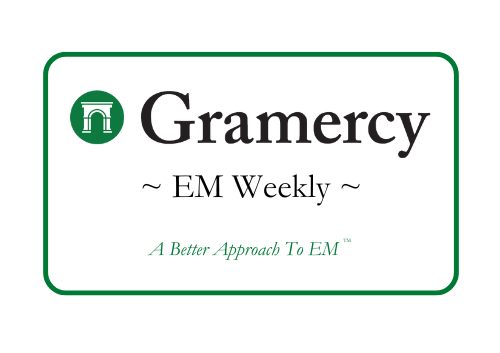Contents
Market Overview
Macro Update
This week, markets were primarily focused on three key topics: tariffs, central bank meetings and U.S. rates.
The Trump Administration confirmed Friday it will start implementing 25% tariffs on Mexico and Canada, and a 10% levy on China, on Saturday, February 1st. The move follows through on campaign promises and further illustrates President Trump’s willingness to weaponize tariffs as he pursues his second-term agenda.
The Administration also took a hard line on tariffs earlier in the week, after Colombian President Gustavo Petro initially refused to allow U.S. military aircraft carrying deportees to land. President Trump promptly threatened to impose 25% tariffs on all Colombian imports and implement travel bans on Colombian officials. Faced with the potential economic and financial repercussions, Colombia agreed to accept deportation flights and avert the penalties.
U.S. rates were also in focus this week as the FOMC kept policy unchanged in a unanimous decision at 4.25 to 4.5%, unlike the Bank of Canada which cut by 25bps. In his press conference, Chair Jerome Powell sounded somewhat more dovish than the FOMC statement. Interestingly, yields on U.S. 10-year government bonds traded down by almost 11bps, ending the week at 4.51%.
U.S. equities ended higher, with the S&P up 0.2%. The U.S. dollar strengthened again, with the DXY Index increasing 0.5% to 107.9.
In terms of economic data, U.S. durable goods orders unexpectedly fell in December, while Consumer Confidence came in slightly lower than expected ahead of the Fed meeting on January 29th. The fourth quarter 2024 Employment Cost Index came out in line with consensus at 0.9%, but still above the prior period’s reading of 0.8%. The Core PCE Index, a key indicator for underlying inflation, was stable for January at 2.8% YoY but still above the Fed’s target (with headline at 2.6%). Markets are currently pricing in close to 50bps of Fed rate cuts until end of 2025.
Meanwhile, the ECB cut its policy rates by 25bps, as expected, following a lacklustre fourth quarter GDP growth release of 0.0% QoQ. Markets are currently pricing in just over 80bps rate cuts from the ECB until the end of 2025.
EM Credit Update
Despite all the noise regarding tariffs, emerging market sovereign credit (cash bonds) ended the week up +0.6% with credit spreads largely unchanged (+1bp). Emerging market corporate credit also ended the week up +0.3% with credit spreads wider by 4bps. Driven by the move tighter in U.S. Treasuries, investment grade sovereigns and corporates outperformed high yield this week by 23bps and 16bps, respectively, on a total return basis. As expected, local currency sovereigns took the brunt of the volatility, down 0.2% on the week.
Regarding individual sovereigns, Ecuador’s USD bonds were the outperformer of the week, driven by opinion polls showing increasing chances of incumbent President Noboa winning the February 9th elections. Gabon was the underperformer this week as investors took profits following a strong rally in January and Fitch downgraded the sovereign one notch to CCC, citing fiscal deterioration and political risk around the April 12th presidential election.
There were three main topics in EM credit this week.
First, tariffs, tariffs, tariffs. The public spat with the Colombian government was a reminder to emerging market economies that there is a new world order in place to navigate.
Second, China’s January manufacturing activity contracted unexpectedly to 49.1 (from 50.1 in December), hitting a five-month low. The lower-than-expected services PMI figure also disappointed consensus forecasts, keeping calls for added stimulus alive and well.
Third, emerging markets central banks were in focus as Chile and Hungary held rates steady, Brazil hiked its rate by 100bps and South Africa cut by 25bps, all in line with consensus expectations. Argentina also cut its benchmark rate by 300bps to 29%, following positive inflation developments.
On the new issue front, it was another relatively quiet week for emerging market sovereign bond issuance, with only Mexico and Egypt coming to market. However, the latter saw its first USD Eurobonds in almost two years, with an oversubscription of approximately five times issuance. Corporate issuance continued to be strong with eight new issues, including the first Kazakhstan bank deal in 11 years.
The Week Ahead
In terms of U.S. economic data, the market will be waiting for the all-important monthly jobs report on Friday, February 7th. Before that, look for the PMI, ISM data, job vacancies and quits (JOLTS) and trade.
The Eurozone and several other countries, including China, will release their PMI’s. The focus will be on whether the services component continues to outperform manufacturing PMIs. Eurozone, Turkish, Indonesian, Korean and Mexican January CPIs will also be released throughout the week, while China’s CPI is set to be released on Sunday, February 9th. Germany will release industrial production data Friday, February 7th.
Looking to central banks, Poland, the UK, Czech Republic, Mexico and India will all have rate-setting meetings throughout the week.
Fixed Income
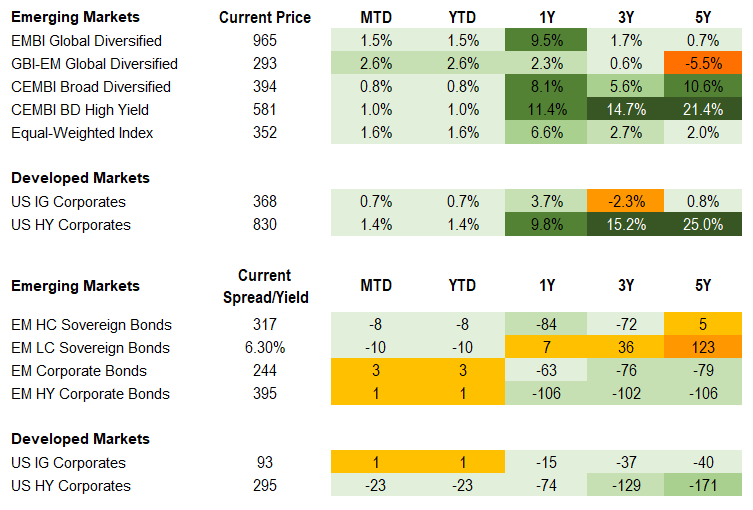
Equities
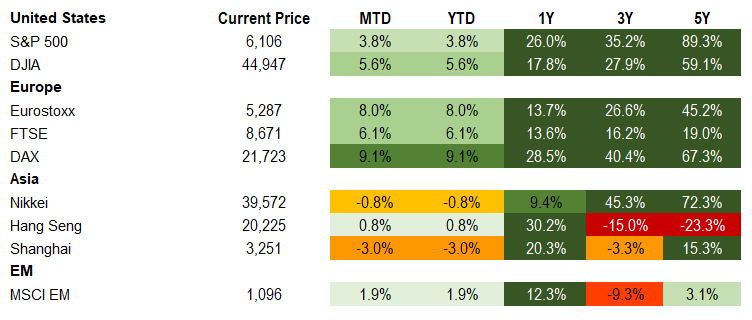
Commodities

Source for data tables: Bloomberg, JPMorgan, Gramercy. EM Fixed Income is represented by the following JPMorgan Indicies: EMBI Global, GBI-EM Global Diversified, CEMBI Broad Diversified and CEMBI Broad High Yield. DM Fixed Income is represented by the JPMorgan JULI Total Return Index and Domestic High Yield Index. Fixed Income, Equity and Commodity data is as of January 31, 2025 (mid-day).
Country Highlights
Brazil’s Central Bank maintains rate hiking cycle under new leadership
Event: The Central Bank of Brazil (BCB) raised the Selic, its main policy rate, by another 100 bps to 13.25% and guided toward a third consecutive rate hike of the same magnitude at the next COPOM meeting, in March.
Gramercy Comment: The BCB policymakers are concerned about inflation dynamics that remain above target and, most of all, about medium-term inflation expectations that continue to be “unanchored”, according to the COPOM’s assessment. The external backdrop also remains challenging and near-term global economic uncertainty has increased.
On the domestic front, one of Brazil’s main inflation drivers has been looser-than-expected fiscal policy by the Lula Administration, which has forced the BCB to revert to aggressive tightening. This latest 100bps hike comes under new BCB Governor Gabriel Galipolo, a Lula appointee, and a Lula-appointed majority on the BCB’s rate-setting committee. The tightening comes amid consistent calls from Lula for lower rates, illustrating the institutional independence of the BCB, a credit positive.
Looking beyond 1Q, we expect Brazil’s monetary policy and inflation outlook to remain dependent on fiscal developments and the willingness, or lack thereof, of the Lula Administration to curtail public spending. As we edge closer to elections in 2026, we believe real rates in Brazil’s economy are likely to remain elevated and we expect the Selic to peak around 15% in the current cycle.
South Africa Reserve Bank delivered hawkish 25bps rate cut
Event: South Africa’s Central Bank lowered its policy rate by 25bps to 7.5%. Four committee members were in favor of the reduction while two voted to remain on hold following a unanimous decision at the prior meeting. The inflation outlook was largely unchanged while the 2025 growth forecast was marginally lifted to 1.8%, moderately higher than IMF and market consensus estimates.
Gramercy Comment: The cut was in line with our expectations. However, the split decision, coupled with a cautious tone in the Monetary Policy Committee (MPC) statement and Governor Kganyago’s comments on external risks, suggest a higher bar for future cuts. Further easing will likely require lower inflation and limited rand volatility.
Serbian President Vucic under pressure as street protests fail to abate despite government resignations.
Event: Mass street protest across Serbia have continued unabated this week despite the resignation of Prime Minister Milos Vucevic and the collapse of his government.
Gramercy Comment: Prime Minister Vucevic, a mentee and close ally of powerful President Alexandar Vucic, resigned to “take political responsibility” and to appease protestors in the Western Balkans country. Protests began with student-led demonstrations following a deadly roof collapse in a newly renovated railway station. The protests have since attracted larger swaths of society and have coalesced around broad social grievances over the rule of law and corruption under President Vucic, who has dominated Serbian political life for over a decade.
Internationally, Serbia has been playing a challenging geopolitical balancing act: while formally an EU candidate, under President Vucic the country has maintained a friendly relationship with Russia, proclaimed ambitions to be China’s top investment destination in CEE and emphasized the friendship of President Trump. A potential political change in Serbia could tilt the country’s geopolitical orientation toward one of the camps, especially amid geopolitical shifts under Trump 2.0. However, we think President Vucic will be hard to dislodge, given the relative weakness and lack of cohesion among the Serbian opposition.
Emerging Markets Technicals
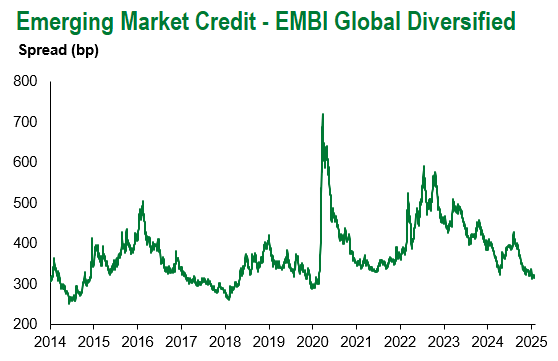
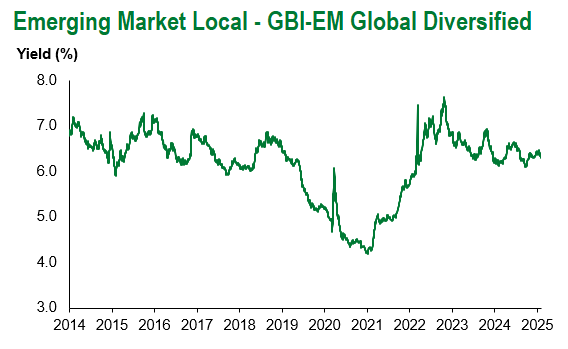
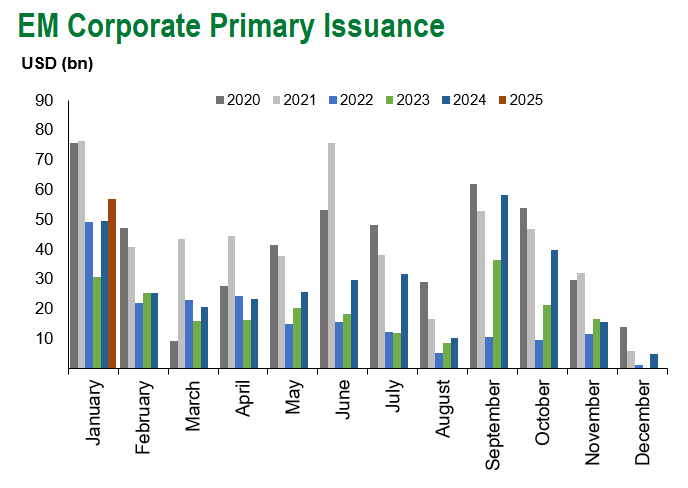
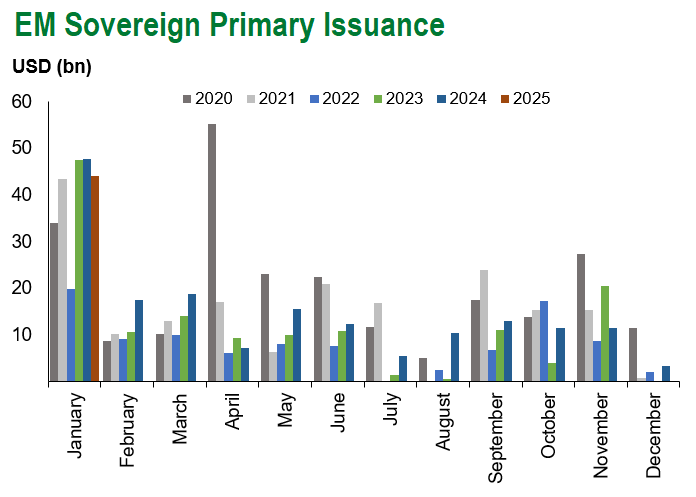
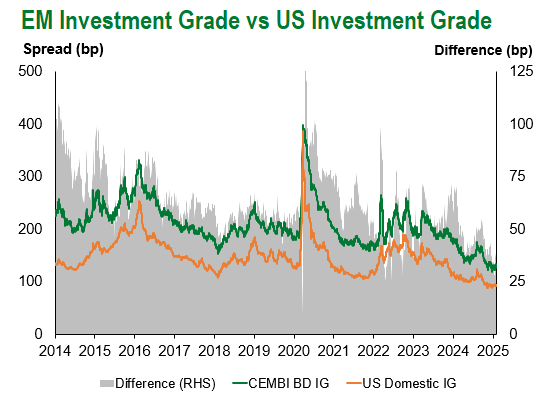
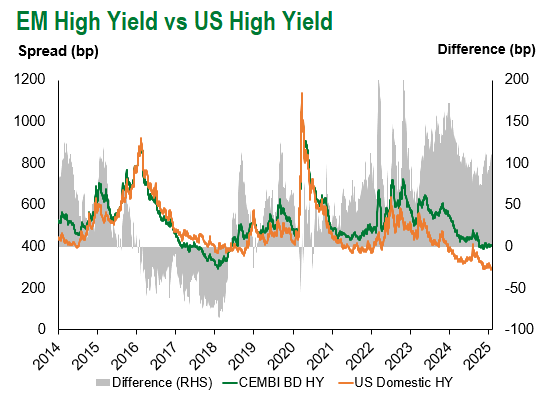
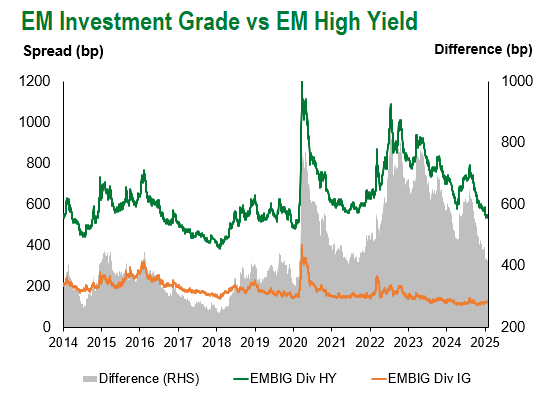
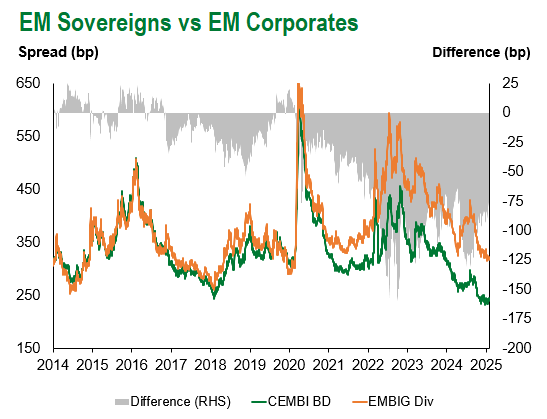
Emerging Markets Flows
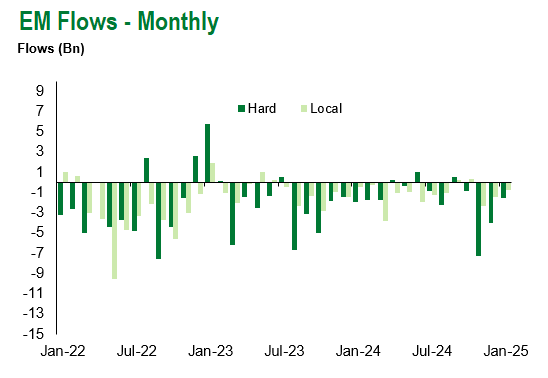
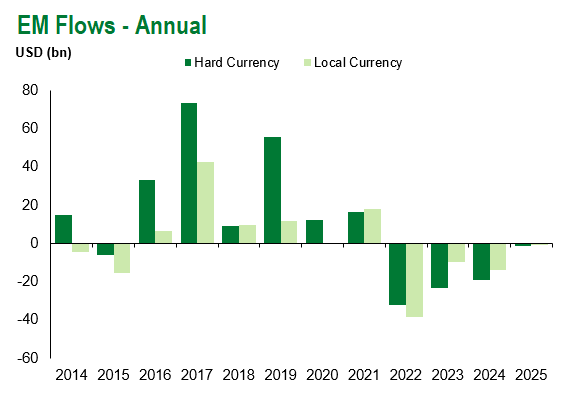
Source for graphs: Bloomberg, JPMorgan, Gramercy. As of January 31, 2025.
For questions, please contact:
Simon Quijano-Evans, Managing Director, Chief Strategist, [email protected]
Kathryn Exum, CFA ESG, Director, Co-Head of Sovereign Research, [email protected]
Petar Atanasov, Director, Co-Head of Sovereign Research, [email protected]
This document is for informational purposes only. The information presented is not intended to be relied upon as a forecast, research or investment advice, and is not a recommendation, offer or solicitation to buy or sell any securities or to adopt any investment strategy. Gramercy may have current investment positions in the securities or sovereigns mentioned above. The information and opinions contained in this paper are as of the date of initial publication, derived from proprietary and nonproprietary sources deemed by Gramercy to be reliable, are not necessarily all-inclusive and are not guaranteed as to accuracy. This paper may contain “forward-looking” information that is not purely historical in nature. Such information may include, among other things, projections and forecasts. There is no guarantee that any forecasts made will come to pass. Reliance upon information in this paper is at the sole discretion of the reader. You should not rely on this presentation as the basis upon which to make an investment decision. Investment involves risk. There can be no assurance that investment objectives will be achieved. Investors must be prepared to bear the risk of a total loss of their investment. These risks are often heightened for investments in emerging/developing markets or smaller capital markets. International investing involves risks, including risks related to foreign currency, limited liquidity, less government regulation, and the possibility of substantial volatility due to adverse political, economic or other developments. References to any indices are for informational and general comparative purposes only. The performance data of various indices mentioned in this update are updated and released on a periodic basis before finalization. The performance data of various indices presented herein was current as of the date of the presentation. Please refer to data returns of the separate indices if you desire additional or updated information. Indices are unmanaged, and their performance results do not reflect the impact of fees, expenses, or taxes that may be incurred through an investment with Gramercy. Returns for indices assume dividend reinvestment. An investment cannot be made directly in an index. Accordingly, comparing results shown to those of such indices may be of limited use. The information provided herein is neither tax nor legal advice. Investors should speak to their tax professional for specific information regarding their tax situation.
